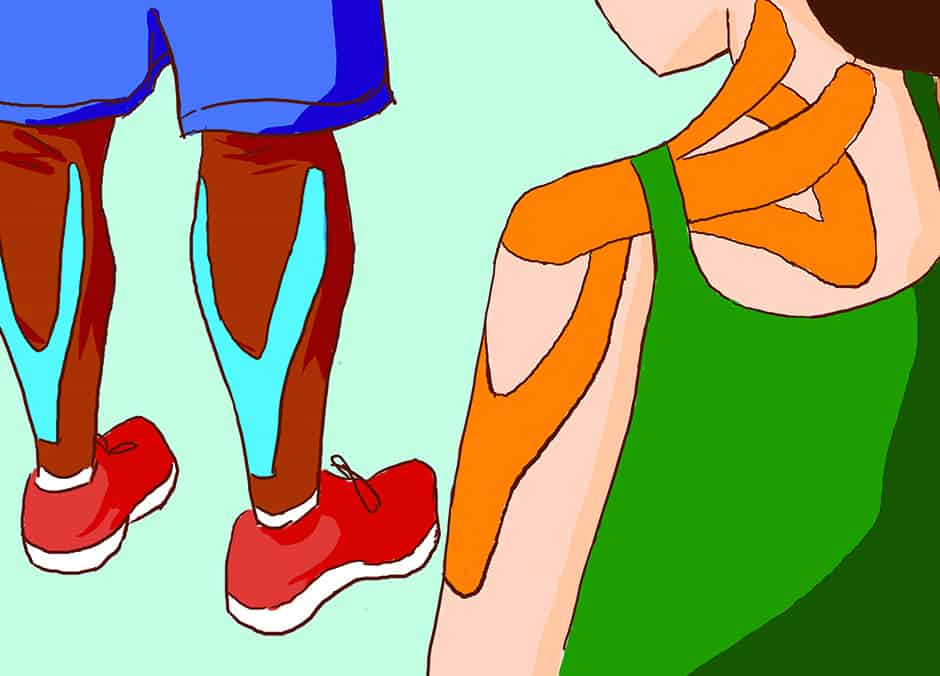Recovering from injuries and alleviating pain are of importance to high-level athletes whose goal is to return to action as soon as possible — ideally, without the help of painkillers. A modern response to this persistent problem is Kinesio tape (K-tape), the colourful bands of tape that have exploded in popularity among athletes of all levels over the last five years.
K-tape originated in the work of Kenzo Kase, a Japanese chiropractor who developed the kinesio taping method in 1975.
Numerous competing companies have since sprung up to offer kinesiology tape, including KT Tape and RockTape. These K-tape companies saw publicity on an international scale at the 1988 Seoul Olympics, where athletes and their trainers began to adopt Kase’s taping methods.
The popularity of K-tape intensified after top athletes, notably biker Lance Armstrong and volleyball player Kerri Walsh, began using the distinctive coloured tape during competition at the 2008 Beijing Olympics.
K-tape targets injured tissue by raising a layer of skin and muscle, allowing for increased flow of bodily fluids to reach the injured area. These fluids, including blood and lymphatic fluid, are essential to the healing process, thereby shortening recovery time.
While this process reduces healing time, K-tape also alleviates pain and supports the muscle during movement. Proper taping increases a targeted muscle’s ability to contract properly, stabilizes the muscle, and reduces the pain associated with moving the tissue.
Although taping was used by athletes to treat injuries before Kase’s developments, K-tape differs from traditional taping techniques.
Prior to K-tape, traditional tape was used to restrict the mobility of injured body parts in order to reduce the risk of aggravation. This method was effective in preventing further injury, but it limited blood flow and slowed down the healing process. K-tape aims to stabilize the inflamed tissues without restricting its motion. The modern tape was designed to have an elasticity that replicates human skin. This elasticity allows for ease of motion and for the tape to apply pressure after it has been stretched.
Dr. Doug Richards, a sports science professor at the University of Toronto, says that the primary difference between the two taping methods is the elasticity of the tape.
“‘K tape’ is highly compliant both along the length of the tape, and across its width. Standard ‘trainer’s tape’ is relatively stiff,” says Richards.
The popularity and visibility of K-tape brought increased levels of scrutiny over its unconfirmed medical claims. This skepticism was summed up in a 2012 study, published in the journal Sports Medicine, that reviewed existing research on K-tape.
The study found inconclusive evidence supporting K-tape’s claims to pain relief and a widened range of motion.
Richards argues that top-level athletes are looking for immediate improvements to their performance and they are not willing to wait for scientific research to be published.
“When we lack evidence-based Rx, we follow heuristics. The prime heuristic is ‘do no harm’ — that is, you may not know if you are helping, but at least don’t make them worse. I suspect K-tape is pretty safe, so I don’t think of it as a harmful practice,” says Richards.
Another response to the criticism of K-tape is that its effects are psychological. Wearing the tape allows athletes to compete with less fear of aggravating their injured muscle, resulting in improved performance.
Despite the concerns surrounding the science behind K-tape’s claims, its popularity suggests that it is here to stay as a viable alternative for athletes facing the wear and tear of competition.


